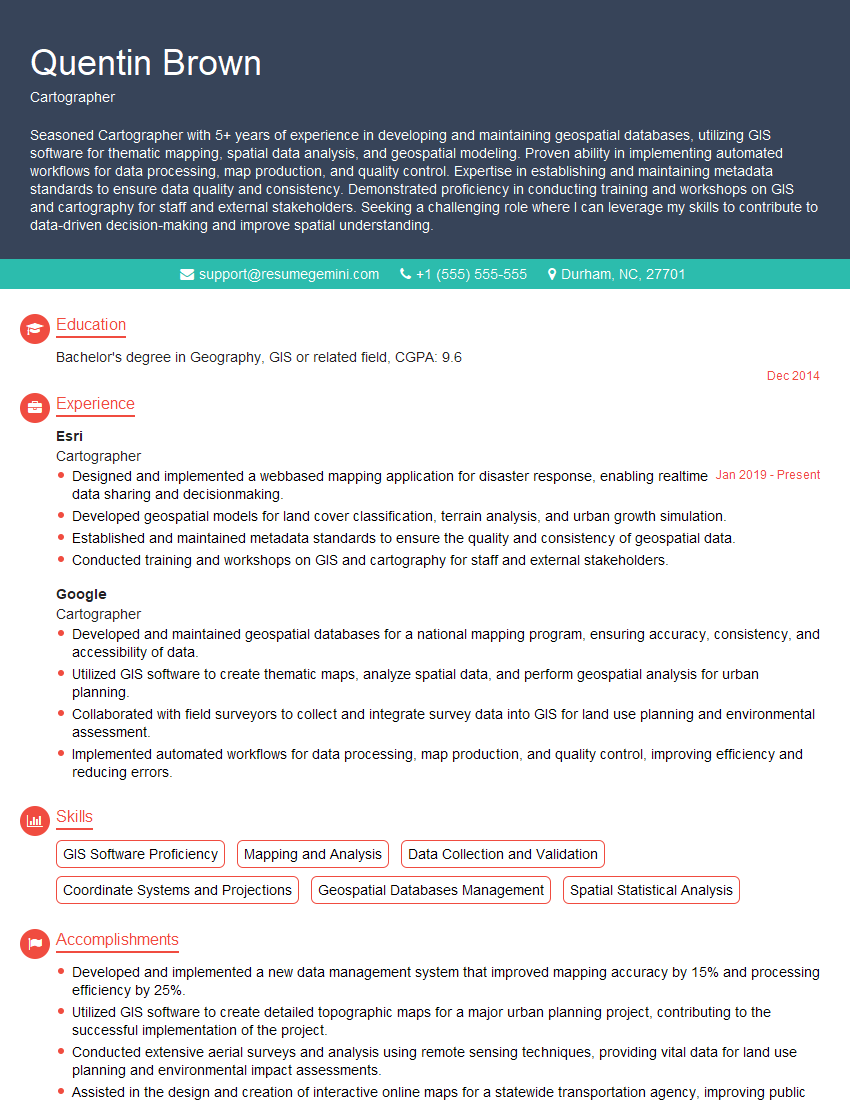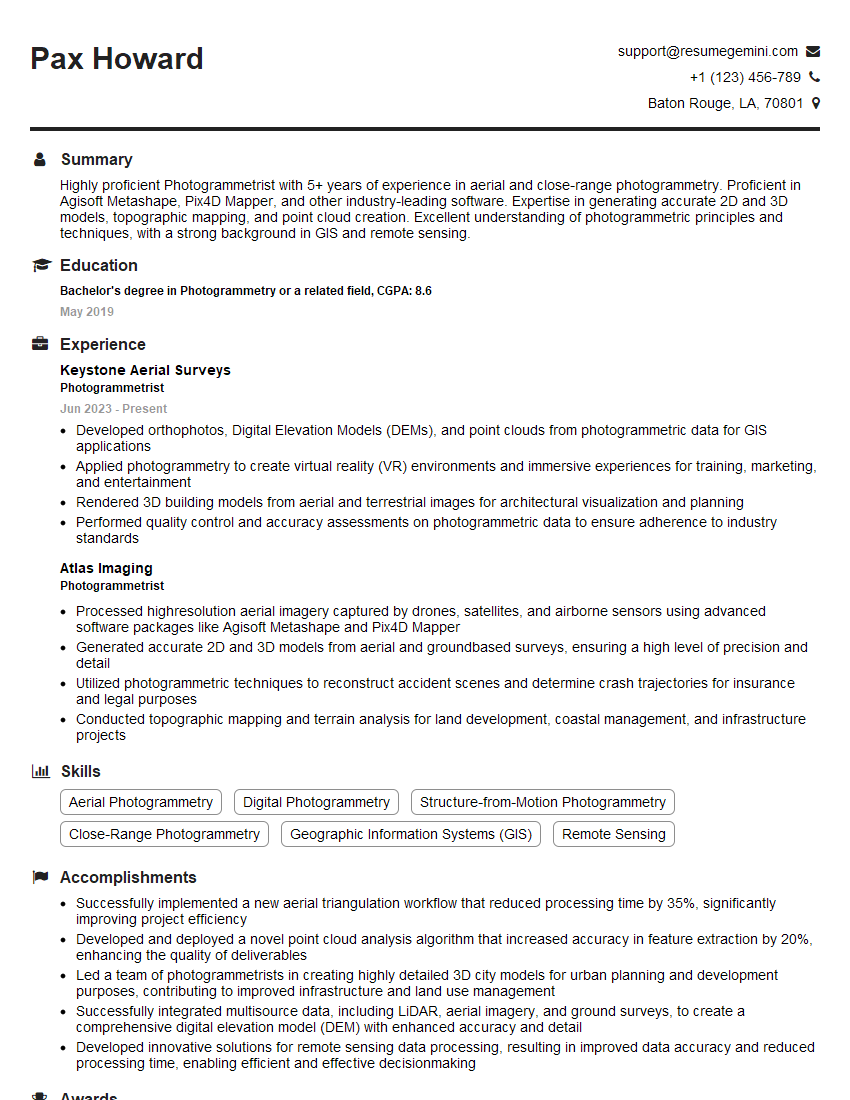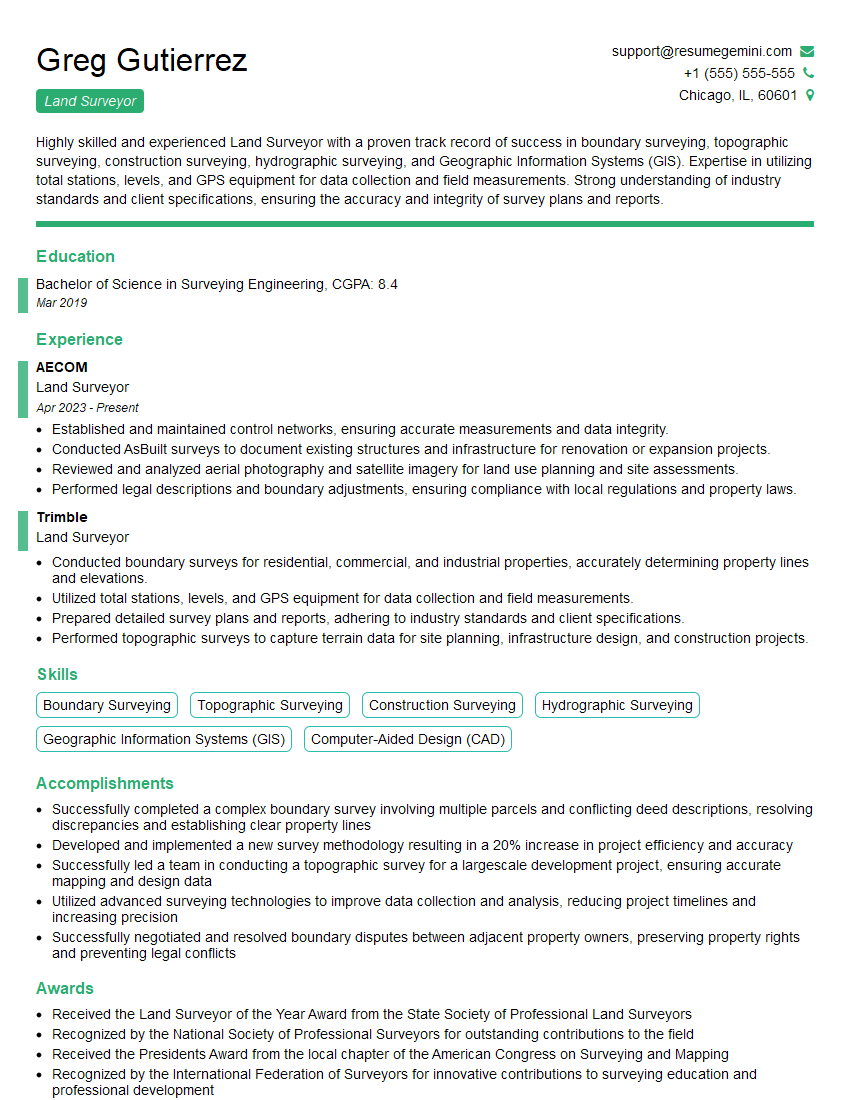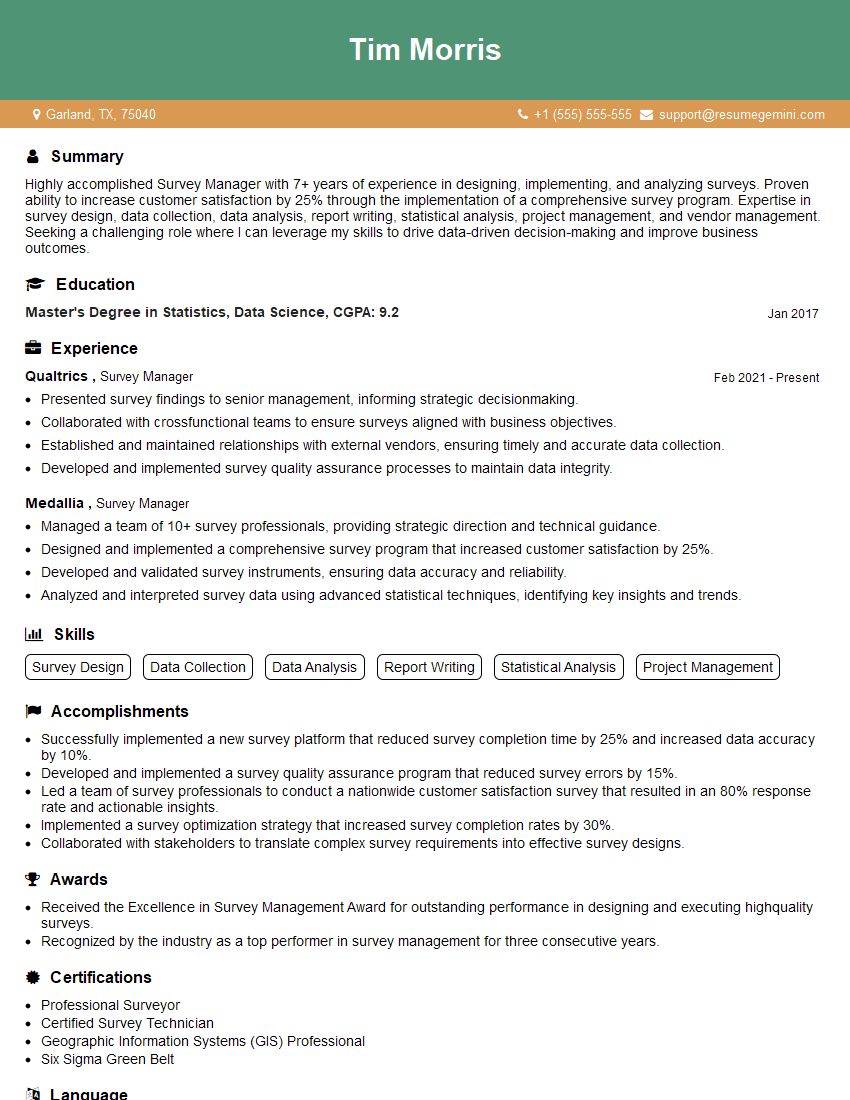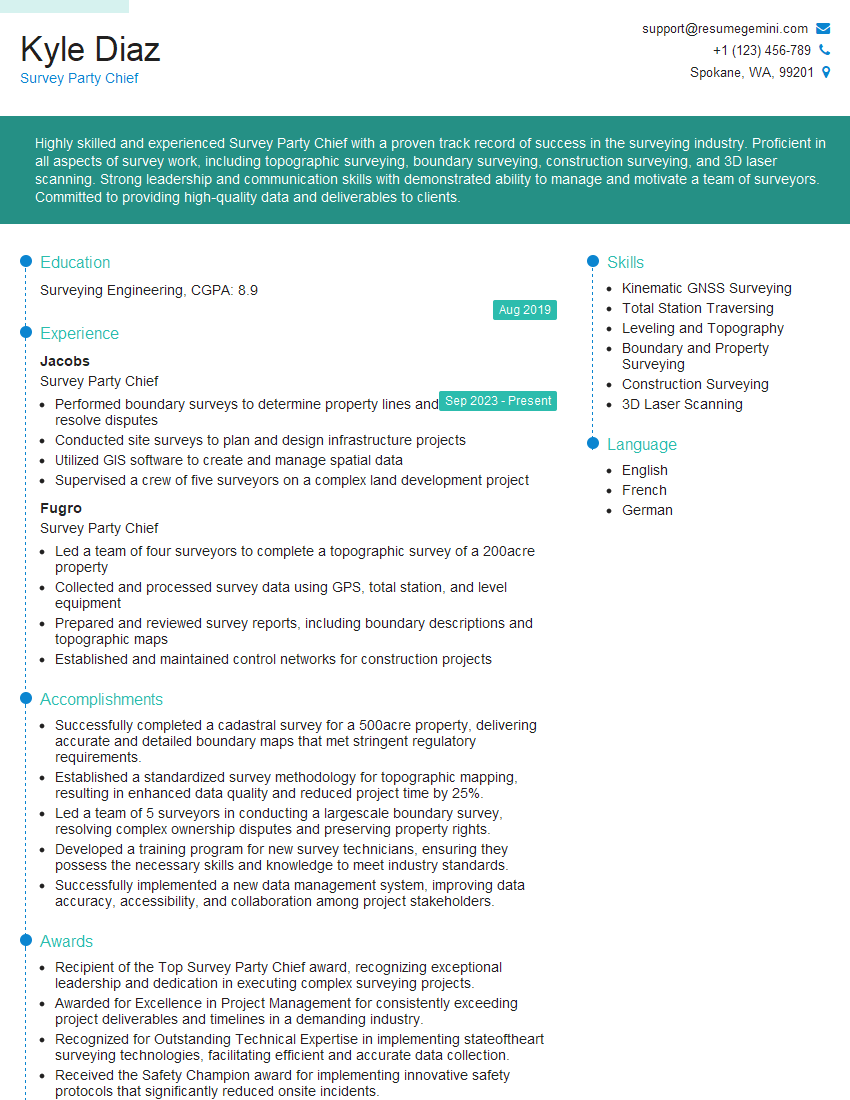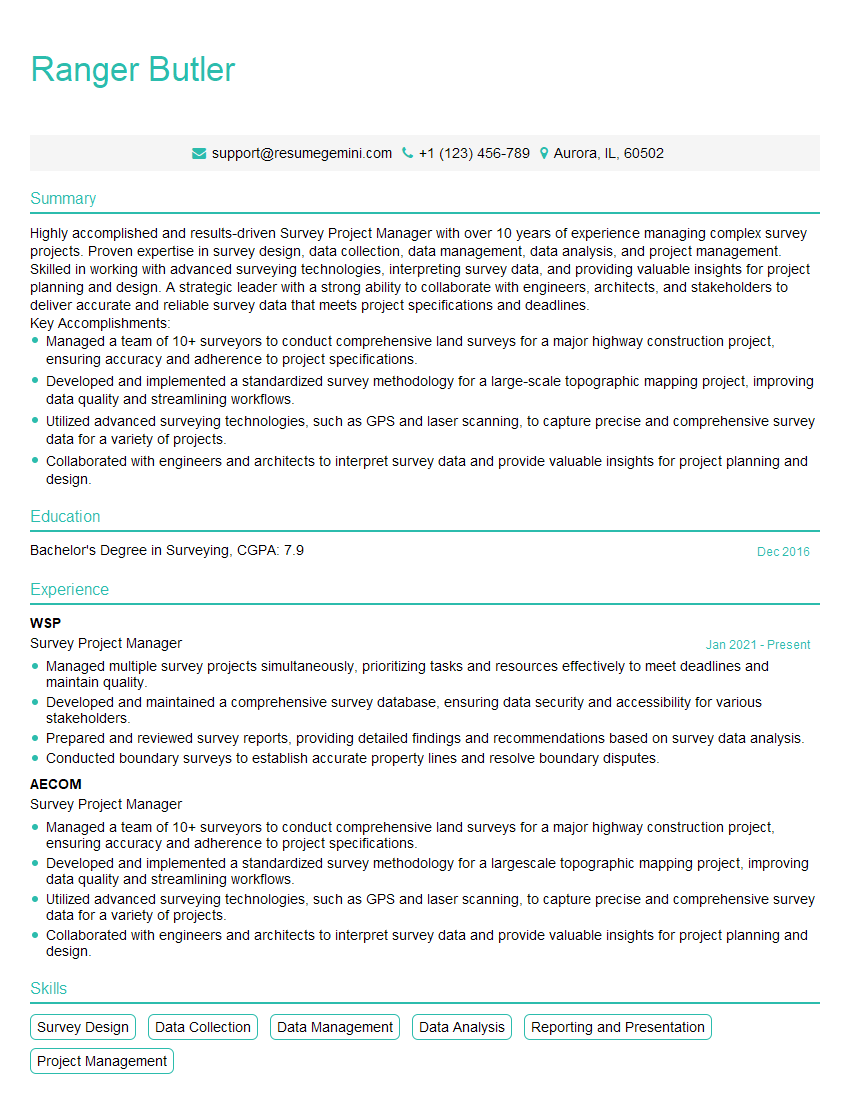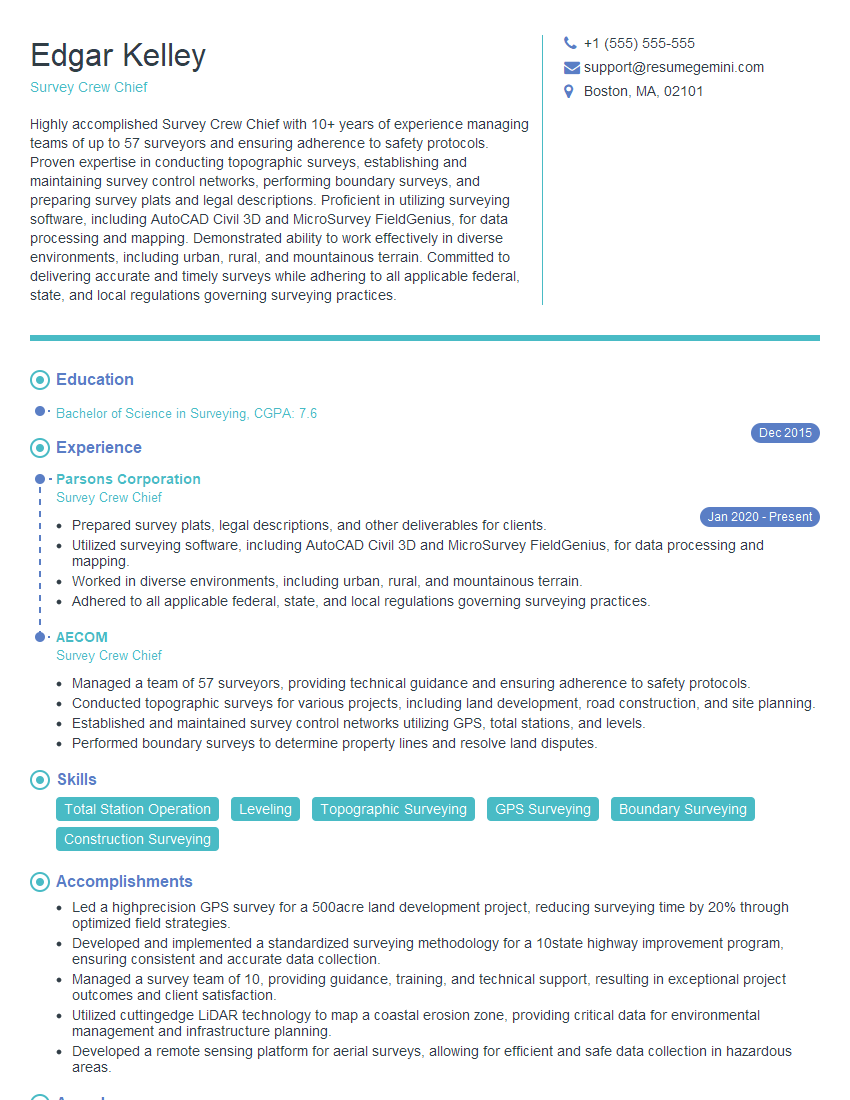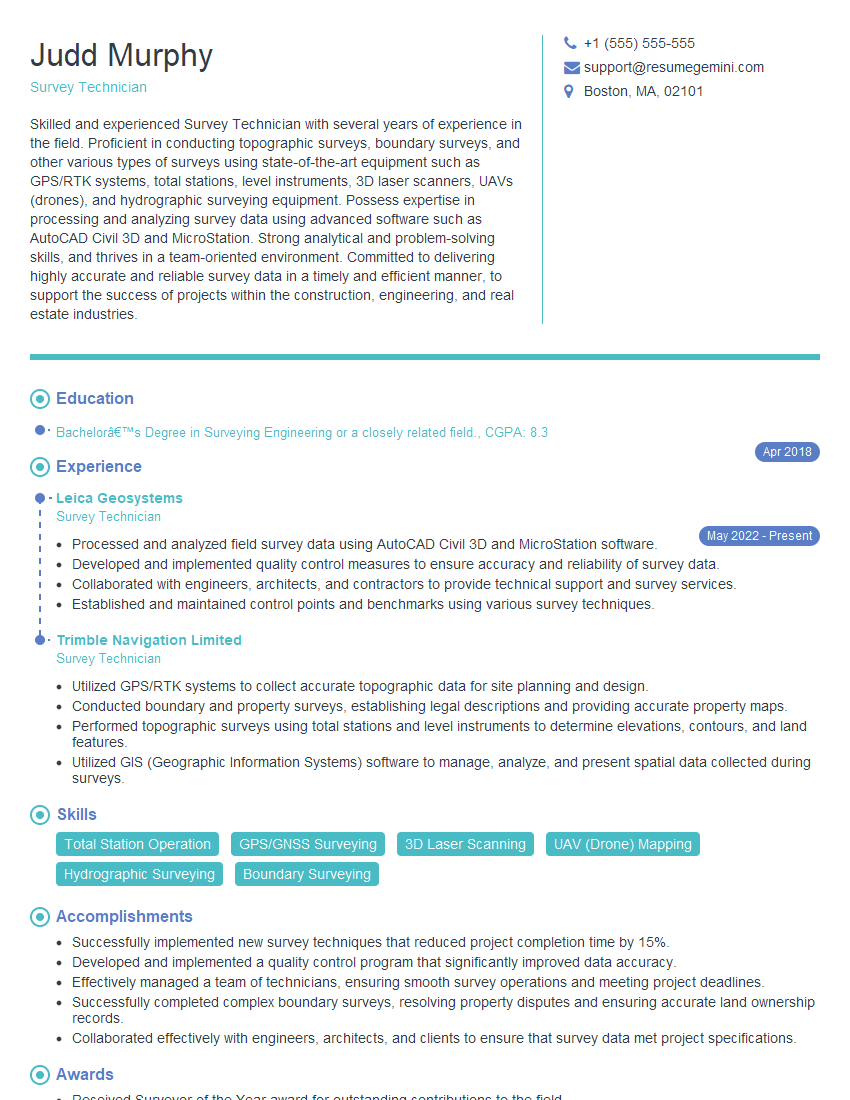Preparation is the key to success in any interview. In this post, we’ll explore crucial Knowledge of surveying ethics and professional standards interview questions and equip you with strategies to craft impactful answers. Whether you’re a beginner or a pro, these tips will elevate your preparation.
Questions Asked in Knowledge of surveying ethics and professional standards Interview
Q 1. Define professional negligence in the context of surveying.
Professional negligence in surveying, often called malpractice, occurs when a surveyor fails to exercise the level of care, skill, and diligence that a reasonably competent surveyor would have exercised in similar circumstances. This failure results in harm or loss to a client or third party.
For example, negligence could involve making significant errors in boundary determination due to inadequate fieldwork or improper use of equipment, leading to property disputes and financial losses for the client. Another example would be failing to identify and report potential hazards on a site, resulting in injury or damage during construction.
Essentially, it boils down to a breach of the duty of care owed to the client and others. This duty of care implies that the surveyor must act with competence, accuracy, and professionalism.
Q 2. Explain the importance of maintaining accurate survey records.
Maintaining accurate survey records is paramount for several reasons. These records serve as a crucial legal and technical document, providing evidence of the surveyor’s work and the property’s condition. Accurate records are essential for:
- Preventing disputes: Precise records can prevent boundary disputes and other legal conflicts by providing clear and indisputable evidence of property lines and features.
- Supporting future projects: Accurate records provide a valuable foundation for future surveying and engineering projects on the same site or in the surrounding area.
- Ensuring liability protection: Well-maintained records can protect the surveyor against claims of negligence or professional malpractice by demonstrating adherence to professional standards.
- Facilitating land transactions: Accurate surveys are crucial for smooth and accurate land transactions, ensuring that buyers and sellers have a clear understanding of the property boundaries.
Imagine a scenario where a surveyor’s records are incomplete or inaccurate. A subsequent land owner could face significant problems, possibly expensive legal battles, stemming from unclear property lines. Accurate records provide a safety net against this type of issue.
Q 3. Describe the ethical implications of using outdated survey equipment.
Using outdated survey equipment has significant ethical implications. It compromises the accuracy and reliability of survey data, potentially leading to errors that could have serious consequences. This violates the ethical obligation to provide competent and professional services.
For example, relying on older Total Stations with less precise measurement capabilities, or using outdated GPS technology, could lead to inaccurate boundary determination or elevation readings. This could cause financial losses for clients, and even endanger lives if the resulting errors affect construction projects or infrastructure planning.
Ethically, a surveyor has a responsibility to maintain proficiency in their field, and this includes investing in and using the most up-to-date equipment available. It’s not only about complying with the letter of the law but upholding the professional standards expected of a competent surveyor. Choosing to use outdated equipment is a breach of this ethical obligation and could constitute negligence.
Q 4. How do you handle a conflict of interest situation in a surveying project?
Handling a conflict of interest requires transparency, objectivity, and adherence to professional ethics. The first step is to recognize the potential conflict. This might involve a personal relationship with a client, ownership interest in a property being surveyed, or involvement in a related project that could influence the objectivity of the survey work.
Upon identification, the next step is to disclose the potential conflict to all involved parties – clients, colleagues, and any relevant regulatory bodies. This disclosure promotes transparency and allows for informed decisions. If the conflict cannot be resolved through disclosure and cannot be mitigated in any way, the ethical course of action is to decline the project to avoid any compromise to the integrity of the survey work. The surveyor’s primary responsibility is to their client and the public; their independence and objectivity must be maintained at all costs.
Consider a scenario where a surveyor is asked to survey a property owned by a close relative. The ethical approach would be to disclose this relationship upfront and possibly recommend another surveyor to conduct the work, thereby avoiding any perception of bias or favoritism.
Q 5. What are the key principles of the surveying professional code of ethics?
The key principles of a surveying professional code of ethics typically revolve around:
- Integrity and Honesty: Surveyors must be truthful and transparent in their dealings, avoiding any deception or misrepresentation of data or findings.
- Competence and Professional Development: Surveyors are obligated to maintain their professional skills and knowledge through ongoing education and training, using appropriate technology and methods.
- Objectivity and Impartiality: Surveyors must conduct their work objectively, free from bias or influence from personal interests, political considerations, or external pressure.
- Confidentiality: Surveyors must protect the confidentiality of client information and data obtained during the course of their work.
- Public Interest: Surveyors have a responsibility to serve the public interest by ensuring accurate and reliable survey data that contributes to safe and sustainable development.
- Compliance with Laws and Regulations: Surveyors must adhere to all relevant laws, regulations, and professional standards in their practice.
These principles are not merely suggestions; they are fundamental to maintaining the public trust and confidence in the surveying profession.
Q 6. Explain the legal responsibilities of a surveyor regarding boundary disputes.
A surveyor’s legal responsibilities in boundary disputes are significant. They’re not just about measuring lines; they involve providing expert testimony and potentially facing legal action if their work is found to be negligent or inaccurate. The surveyor’s role often involves:
- Conducting thorough investigations: This includes reviewing title deeds, historical maps, and other relevant documents to establish the boundaries based on legal evidence.
- Performing accurate surveys: Using appropriate equipment and methodology to precisely determine boundary locations on the ground.
- Preparing detailed reports: Presenting clear and comprehensive reports that document the survey procedures, findings, and interpretations.
- Providing expert testimony: The surveyor may be called upon to give evidence in court regarding boundary disputes, explaining their findings and methodology.
Failure to meet these responsibilities can lead to legal liability for the surveyor if their work is found to be inaccurate or negligent, resulting in financial losses or other damages for the parties involved. The surveyor is expected to act as a neutral expert, providing objective findings based on evidence and professional standards.
Q 7. Describe your understanding of professional liability insurance for surveyors.
Professional liability insurance, also known as errors and omissions (E&O) insurance, is crucial for surveyors. It protects them against financial losses arising from claims of professional negligence, errors, or omissions in their work.
This insurance covers legal costs, settlements, and judgments awarded against the surveyor due to claims of negligence. For example, if a surveyor makes an error in boundary determination that leads to a property dispute, the E&O insurance can help cover the costs associated with defending the claim and any potential settlements or judgments.
It is essential because the consequences of professional errors can be severe, involving substantial financial losses and reputational damage. Professional liability insurance provides a financial safety net, protecting the surveyor’s business and personal assets from potential legal claims.
Q 8. How do you ensure the accuracy and reliability of your survey data?
Ensuring accurate and reliable survey data is paramount. It’s the foundation upon which all subsequent decisions are made. My approach is multi-faceted and begins even before fieldwork commences. First, I meticulously plan the survey, carefully selecting appropriate methodologies and equipment based on the project’s specific requirements and the terrain. This includes considering factors like the scale of the project, the required level of precision, and potential environmental challenges.
During fieldwork, I employ rigorous quality control procedures. This involves regular instrument calibration, utilizing redundant measurements to detect and account for potential errors (such as using both total station and GPS data for comparison and validation), and maintaining detailed field notes. For instance, if we’re surveying a property boundary, we wouldn’t rely on just one measurement but would take multiple measurements from different points, utilizing different instruments where possible. Any discrepancies are investigated immediately and documented. Post-processing involves thorough data analysis using sophisticated software. This includes identifying and correcting any outliers or systematic errors, as well as applying appropriate adjustments based on atmospheric conditions.
Finally, a rigorous quality assurance process concludes the project. This often involves peer review of the data and results by another experienced surveyor to catch any potential oversights. The final report clearly documents all procedures, uncertainties, and limitations, ensuring complete transparency and traceability. This comprehensive approach guarantees the highest level of accuracy and reliability of the survey data.
Q 9. What steps do you take to protect client confidentiality in surveying projects?
Client confidentiality is of utmost importance and is ethically and legally mandated. I treat all client data as strictly confidential, adhering to all relevant privacy regulations and company policies. This includes data encryption both in transit and at rest. All project-related information, whether digital or hard copy, is stored securely and access is strictly limited to authorized personnel only. We maintain detailed access logs and regularly review security protocols.
Furthermore, I use non-disclosure agreements (NDAs) with all involved parties, ensuring that everyone working on the project understands and agrees to the confidentiality obligations. Even in informal discussions or presentations, I avoid revealing client-specific information that isn’t publicly known or previously consented to. For example, if I’m discussing a project at a conference, I would use general examples and avoid specifics that could identify the client. This commitment to confidentiality builds trust and ensures that clients feel secure in sharing their information with us.
Q 10. Explain your process for addressing discrepancies or errors in survey data.
Discrepancies or errors in survey data are inevitable, but how they’re addressed is crucial. My process begins with careful identification of the discrepancies. This involves a thorough review of the field data, comparing measurements and looking for any outliers or inconsistencies. If a discrepancy is identified, I don’t immediately discard it. I investigate the potential causes. Were there any environmental factors influencing the measurement? Was there a possible equipment malfunction? Was there a miscalculation in the data processing?
Next, I determine the significance of the error. Is it a minor discrepancy that can be safely ignored, or does it significantly impact the accuracy of the final results? If the error is significant, I trace it back to its source and attempt to re-measure or correct it. This might involve returning to the field, re-checking equipment calibrations, or performing further calculations. If the source of the error cannot be definitively determined, I document all my investigations and analysis, and transparently report the uncertainty to the client. This approach prioritizes accuracy, but acknowledges the inherent limitations of measurement and emphasizes transparency above all else.
Q 11. Describe your experience in using survey technologies that adhere to industry standards.
I have extensive experience using a variety of survey technologies, all adhering to industry-standard best practices. My experience encompasses traditional methods like total stations and levels, along with modern technologies such as GPS, GNSS (Global Navigation Satellite Systems), and laser scanning. I’m proficient in using various software packages for data processing and analysis, including AutoCAD Civil 3D and ArcGIS.
For instance, I’ve utilized RTK (Real-Time Kinematic) GPS systems for high-precision surveys requiring centimeter-level accuracy, such as setting out critical infrastructure elements. In other projects, I’ve employed terrestrial laser scanning to quickly and efficiently capture vast amounts of three-dimensional data for large-scale construction projects or building modeling, greatly improving both speed and the detail of our data acquisition. I also have expertise in using drone technology for aerial surveys, reducing fieldwork time and cost, particularly in challenging terrains. All my work is always done adhering to the latest standards and regulations, ensuring data accuracy and integrity.
Q 12. How do you comply with relevant environmental regulations in your surveying work?
Environmental compliance is a critical aspect of surveying. Before starting any project, I conduct a thorough environmental site assessment, identifying potential environmental sensitivities and hazards. This assessment considers factors such as protected species, wetlands, endangered ecosystems, and potential soil contamination. Based on this assessment, I develop a site-specific environmental management plan that outlines strategies for minimizing the environmental impact of our surveying activities.
This plan includes measures for preventing soil erosion, protecting water bodies from contamination, and avoiding disturbances to sensitive habitats. We are careful to comply with all relevant local, state, and national environmental regulations. We obtain necessary permits before commencing fieldwork and ensure our staff receives appropriate training in environmental protection and safety protocols. For instance, if we’re working near a waterway, we’d use specific techniques to avoid disturbing sediment and carefully manage any waste materials generated during the project. Our commitment to environmental responsibility is reflected in our operational procedures and contributes to responsible land management.
Q 13. Explain how you maintain professional development in the field of surveying.
Maintaining professional development is crucial in the constantly evolving field of surveying. I actively participate in professional organizations such as the [Mention relevant professional surveying organization], attending conferences, workshops, and seminars to stay abreast of the latest technologies, techniques, and industry best practices. I also regularly engage in continuing education courses to maintain and improve my professional skills and certifications.
In addition to formal training, I actively seek opportunities for personal and professional growth through mentoring junior surveyors, sharing my knowledge and experience, and collaborating on challenging projects. I stay informed by reading professional journals and publications, and I actively seek feedback from my peers and clients to continuously refine my skills. This commitment to ongoing professional development ensures that I maintain the highest standards of competency and ethical conduct in my practice. In essence, continuous learning is a cornerstone of my career.
Q 14. What is your approach to managing time and resources effectively in survey projects?
Effective time and resource management are essential for successful survey projects. My approach begins with detailed project planning. This involves a comprehensive assessment of the project scope, defining clear objectives, establishing timelines, and identifying the necessary resources (personnel, equipment, software). I break down complex tasks into smaller, manageable units, assigning responsibilities to team members and establishing clear communication channels.
Throughout the project, I monitor progress regularly, tracking milestones, and addressing any potential delays proactively. I utilize project management software to track progress, manage resources, and maintain accurate records. I also foster a collaborative work environment, encouraging open communication and teamwork among team members to ensure efficient workflow. If unexpected challenges or delays arise, I work closely with the client to develop solutions, maintaining transparency and minimizing disruption. By combining careful planning, proactive monitoring, and effective communication, I optimize resource utilization and ensure project delivery within the established timelines and budget.
Q 15. How do you handle unexpected challenges or setbacks during a survey?
Unexpected challenges are par for the course in surveying. My approach focuses on proactive planning and adaptable problem-solving. Before embarking on any survey, I meticulously plan, considering potential obstacles like weather, terrain difficulties, or access limitations. This involves thorough site reconnaissance and contingency planning.
If a setback occurs—say, equipment malfunction in the field—my first step is assessing the situation’s impact on the project timeline and accuracy. I then implement the appropriate contingency plan, which may include deploying backup equipment, adjusting the survey methodology, or seeking expert advice. Open communication with the client throughout this process is key to maintaining transparency and managing expectations. For example, if inclement weather delays a drone survey, I’ll promptly inform the client, offering revised timelines and outlining how we’ll mitigate any potential impacts on the project deliverables.
Transparent and timely communication is crucial; it shows professionalism and prevents misunderstandings. Documenting all challenges and their resolutions is essential for future project planning and continuous improvement.
Career Expert Tips:
- Ace those interviews! Prepare effectively by reviewing the Top 50 Most Common Interview Questions on ResumeGemini.
- Navigate your job search with confidence! Explore a wide range of Career Tips on ResumeGemini. Learn about common challenges and recommendations to overcome them.
- Craft the perfect resume! Master the Art of Resume Writing with ResumeGemini’s guide. Showcase your unique qualifications and achievements effectively.
- Don’t miss out on holiday savings! Build your dream resume with ResumeGemini’s ATS optimized templates.
Q 16. How would you deal with a client who disputes your survey findings?
Client disputes over survey findings are unfortunately common. My approach is centered on professionalism, transparency, and a commitment to accuracy. I would begin by calmly reviewing the client’s concerns, actively listening to understand their perspective. I would then systematically revisit my fieldwork, data processing, and analysis to identify any potential errors or misinterpretations.
If an error is discovered, I would transparently acknowledge it, explain the cause, and propose a course of corrective action. This might involve re-performing certain aspects of the survey or re-analyzing the data. Thorough documentation is critical at this stage, backing up my corrections and explanations.
If, after thorough review, my findings remain consistent and accurate, I would professionally explain the methodology used, the data’s reliability, and the standards adhered to. Presenting clear, well-supported evidence is vital here. If the dispute persists, involving a third-party expert or even arbitration might be necessary. The goal is always a resolution that preserves professional integrity and satisfies the client’s needs as far as is reasonably possible within the bounds of accurate data.
Q 17. Describe your knowledge of surveying regulations and licensing requirements.
My understanding of surveying regulations and licensing requirements is comprehensive. I’m well-versed in the specific regulations governing land surveying within my state/region, including those related to professional licensing, boundary disputes, and data handling. This includes knowledge of the relevant acts and codes that set the standards for professional conduct and practice.
I’m familiar with the requirements for obtaining and maintaining a surveying license, including the educational qualifications, examination processes, and continuing professional development (CPD) obligations. Understanding these regulations allows me to comply with all legal and ethical obligations in every aspect of my work. This commitment extends to using appropriate surveying equipment, adhering to established standards, and understanding relevant health and safety regulations.
Staying updated on changes to these regulations is ongoing. I regularly consult professional journals and attend industry conferences to maintain current knowledge. For example, I regularly check my state’s professional licensing board website for any updates on regulations or changes in licensing procedures.
Q 18. Explain the importance of health and safety procedures in surveying operations.
Health and safety are paramount in surveying. It’s not just about adhering to regulations but about creating a safe working environment for myself and my team. This begins with risk assessments before any job. I identify potential hazards, such as uneven terrain, traffic hazards, or exposure to extreme weather conditions.
Based on this assessment, I develop and implement a comprehensive safety plan. This includes using appropriate personal protective equipment (PPE), like high-visibility clothing, safety boots, and hard hats. It also involves the correct use of surveying equipment, adhering to manufacturers’ safety guidelines and undertaking regular equipment maintenance. For example, when using drones, we meticulously follow all relevant regulations and safety protocols, ensuring the airspace is clear and avoiding any potential hazards.
Regular training and toolbox talks are crucial. My team and I regularly discuss safety procedures, emergency response plans, and the correct handling of equipment. I foster a safety-conscious culture where everyone feels comfortable raising safety concerns without fear of reprisal.
Q 19. How do you ensure compliance with data privacy laws when handling survey data?
Data privacy is crucial. I ensure compliance with all relevant data protection laws, such as GDPR or equivalent regional regulations, when handling survey data. This includes understanding the principles of data minimization, purpose limitation, and storage security.
I employ secure data handling practices throughout the survey process. This involves using secure data storage methods, encrypting sensitive information both in transit and at rest, and controlling access to data on a need-to-know basis. Any data collected is only used for the explicitly stated purpose of the survey, and I obtain explicit consent for data collection where necessary.
Client confidentiality is paramount. I have clear data handling policies and procedures, which are communicated to clients upfront, along with details of how their data will be stored, protected, and eventually disposed of. All data is handled in accordance with these policies and I regularly review and update these policies to reflect changing legislation and best practices.
Q 20. What are the potential ethical issues related to the use of drone technology in surveying?
Drone technology offers significant advantages in surveying, but also introduces ethical considerations. Privacy is a major concern. The ability to capture high-resolution imagery and data raises questions about potential intrusions on individuals’ privacy, particularly when surveying residential areas. It’s crucial to ensure compliance with all relevant regulations regarding airspace use and data acquisition.
Data security is another ethical issue. The data collected by drones is vulnerable to hacking or unauthorized access. Secure data storage and transmission protocols are essential. Transparency is also important. Clients need to be aware of how the drone data will be used and protected.
Finally, responsible use is key. Drone operators must be properly trained and certified, and they should always operate their drones safely and responsibly, respecting both privacy and the environment. For example, we always obtain necessary permissions before operating drones near airports or other restricted areas.
Q 21. How do you address situations where a client pressures you to compromise ethical standards?
Client pressure to compromise ethical standards is unacceptable. My response would be firm and professional. I would clearly and politely explain why the requested actions violate ethical guidelines, referencing specific professional codes of conduct. For example, if a client pressures me to falsify survey results, I would clearly explain the severe legal and professional repercussions of such actions, reiterating my commitment to accuracy and integrity.
If the pressure persists, and the compromise of ethical standards remains a condition of the project, I would refuse to proceed. Protecting my professional integrity and upholding ethical standards is non-negotiable. While maintaining a professional and respectful demeanor, it’s crucial to stand firm on ethical principles. Documenting the client’s requests and my refusal is essential for my own records, potentially as evidence should legal issues arise.
In some instances, I might suggest alternative solutions that meet the client’s needs without compromising ethical standards. This shows professionalism and commitment to finding solutions while maintaining integrity.
Q 22. Explain your understanding of the role of professional organizations in surveying.
Professional organizations play a crucial role in upholding the integrity and standards of the surveying profession. They act as guardians of ethical conduct, providing a framework for best practices, and fostering continuous professional development. Think of them as the ‘police’ and ‘teachers’ of the surveying world, ensuring we all operate by a common set of rules and stay current with advancements.
- Setting Ethical Standards: Organizations like the National Society of Professional Surveyors (NSPS) and state-level licensing boards develop and enforce codes of ethics that guide surveyors’ professional conduct. These codes address issues such as client confidentiality, conflicts of interest, and the accurate representation of data.
- Providing Continuing Education: These organizations offer workshops, seminars, and online resources to keep surveyors updated on the latest technologies, techniques, and legal developments. This is vital in a field constantly evolving with advancements in GPS, GIS, and other technologies.
- Enforcing Professional Standards: They investigate complaints of unethical behavior and provide disciplinary action when necessary, ensuring accountability and protecting the public trust. This maintains the credibility and reputation of the profession.
- Advocacy and Representation: Professional organizations lobby for legislation that supports the surveying profession and protects surveyors’ interests, while also advocating for the public good. For instance, they might advocate for better land management policies or stronger protections for surveyor intellectual property.
In essence, these organizations ensure surveyors work ethically and competently, safeguarding the accuracy and reliability of surveying data used in various critical applications like construction, land development, and environmental management.
Q 23. Describe your experience with peer review and quality control in surveying projects.
Peer review and quality control are integral parts of my surveying workflow, ensuring the accuracy and reliability of project deliverables. I see them as vital steps that enhance trust and credibility. Think of them as a ‘check and balance’ system.
My experience includes participation in both internal and external peer reviews. Internally, we have established rigorous quality control checks at every stage of a project, from data acquisition to final report preparation. For instance, we use independent checks on calculations, field notes, and data processing. Software such as AutoCAD Civil 3D helps with this by enabling cross-referencing and data validation. In a recent project, a colleague independently checked my boundary survey calculations, catching a minor error before it reached the client – a crucial act of preventative quality control.
Externally, I’ve been involved in peer reviews of projects for other firms. This involves critically examining the methodology, data accuracy, and conclusions of another surveyor’s work. The goal isn’t fault-finding, but rather ensuring compliance with professional standards and the delivery of high-quality, dependable results. This collaborative approach leads to learning opportunities and fosters a culture of improvement within the profession.
Q 24. How do you balance the need for efficiency with maintaining the highest ethical standards?
Balancing efficiency with ethical standards is a constant challenge, but it’s paramount to the success and reputation of any surveyor. It’s not about choosing one over the other – instead, it’s about finding creative and intelligent ways to integrate both. It’s like a tightrope walk that requires skill and precision.
One strategy is to leverage technology effectively. Modern surveying equipment and software drastically improve efficiency, reducing fieldwork time and minimizing the chance for human error. GPS, LiDAR, and advanced data processing tools, combined with strong QC protocols are key. This ensures that our projects are completed both rapidly and with accuracy. For instance, using drone technology for topographic surveys significantly cuts down on fieldwork and provides high-resolution data.
Another crucial aspect is proper planning. Thorough site investigation and detailed project planning before starting fieldwork significantly reduces the likelihood of costly rework or errors later on. This proactive approach saves time and resources, while guaranteeing adherence to ethical standards by minimizing the need for rushed corrections.
Finally, strong communication with the client is essential. Clearly defining project scopes and expectations upfront prevents misunderstandings and ensures everyone understands the limitations and potential challenges of the project. This open communication helps prevent compromises in ethical conduct driven by time pressures.
Q 25. Describe a situation where you had to make an ethical decision in a surveying project.
In a recent project involving a property boundary dispute, I faced an ethical dilemma. The client, eager to begin construction, pressured me to expedite the survey and overlook some minor discrepancies in the historical records. While the discrepancies didn’t significantly affect the overall boundary determination, they raised questions about the completeness of the evidence.
My ethical obligation was to ensure the accuracy and integrity of my work. Instead of rushing to meet the client’s deadline, I fully documented my findings, highlighting the minor discrepancies and explaining their potential implications. I then clearly communicated these uncertainties to the client, recommending a more thorough historical title search to confirm the boundary. This thorough approach, though it delayed construction slightly, ultimately protected both the client and my professional reputation by ensuring the integrity of the survey.
This experience reinforced the importance of prioritizing ethical considerations above time pressure, even when faced with client expectations. It demonstrated that transparency and thoroughness are essential in maintaining professionalism and building long-term trust with clients.
Q 26. Explain the difference between legal requirements and ethical best practices in surveying.
Legal requirements and ethical best practices in surveying are closely related but not interchangeable. Legal requirements are the minimum standards mandated by law to ensure public safety and fair practices. Ethical best practices, on the other hand, go beyond the legal minimum, representing the highest standards of professional conduct. Think of it as legal requirements being the floor, and ethical best practices being the ceiling of professional conduct.
For example, laws may mandate specific licensing requirements, data accuracy tolerances, or procedures for boundary disputes. Failure to adhere to these requirements carries legal consequences. However, ethical best practices might involve going the extra mile to verify data through multiple sources, proactively addressing potential conflicts of interest, or voluntarily sharing expertise with colleagues to promote the profession’s overall competence.
Ethical conduct often anticipates and addresses potential problems before they become legal issues. For instance, actively seeking client consent before releasing survey data to third parties is an ethical best practice, even if the law doesn’t explicitly require it. It fosters trust and reinforces professional integrity.
Q 27. How do you stay informed about updates to surveying ethics and professional standards?
Staying current on surveying ethics and professional standards is essential for maintaining my professional competence. This is an ongoing process, not a one-time event. It’s like a lifelong learning journey.
- Professional Organization Membership: Active membership in organizations such as NSPS provides access to publications, webinars, and conferences that discuss updates to ethical codes, new technologies, and emerging legal issues. These resources often provide case studies and practical examples of ethical decision-making.
- Continuing Education Courses: I regularly participate in continuing education courses and workshops focused on ethics, legal updates, and new technologies. Many jurisdictions require a certain number of continuing education hours each year to maintain licensure.
- Professional Journals and Publications: I subscribe to and regularly read surveying journals and industry publications that cover recent developments in technology, case law affecting surveying practices, and evolving ethical considerations within the field. These publications keep me updated on best practices and emerging challenges.
- Networking with Colleagues: Discussing ethical dilemmas and best practices with peers at conferences and workshops provides valuable insights and different perspectives on challenging situations.
By actively engaging in these activities, I can ensure my practices remain up-to-date, ethical, and aligned with the highest standards of the surveying profession.
Key Topics to Learn for Knowledge of Surveying Ethics and Professional Standards Interview
- Professional Codes of Conduct: Understand the core principles of ethical surveying practice, including adherence to relevant professional organizations’ codes of ethics (e.g., NSPS, ACSM). Be prepared to discuss specific examples of ethical dilemmas and how you would approach them.
- Accuracy and Precision in Surveying: Explain the importance of maintaining high standards of accuracy and precision in all surveying activities. Discuss the consequences of errors and how to mitigate them, including quality control procedures and error propagation.
- Data Integrity and Confidentiality: Detail your understanding of data handling procedures, including data security, confidentiality, and the responsible use of surveying data. Explore scenarios involving sensitive data and how to maintain ethical practices.
- Boundary Disputes and Legal Issues: Discuss the role of surveyors in resolving boundary disputes and the legal implications of surveying work. Explain how to handle conflicts of interest and navigate legal challenges ethically and professionally.
- Professional Liability and Insurance: Understand the importance of professional liability insurance and the potential legal risks associated with surveying. Be prepared to discuss risk management strategies and best practices for avoiding liability.
- Client Relations and Communication: Discuss effective communication with clients, including clear and concise reporting, managing expectations, and addressing client concerns ethically and professionally. Explore scenarios requiring sensitive communication.
- Sustainability and Environmental Considerations: Understand the environmental impact of surveying activities and ethical considerations related to land use and resource management. Discuss sustainable surveying practices.
Next Steps
Mastering Knowledge of surveying ethics and professional standards is crucial for building a successful and reputable career. Demonstrating a strong understanding of these principles will significantly enhance your interview performance and long-term career prospects. To further strengthen your application, create an ATS-friendly resume that highlights your relevant skills and experience. We highly recommend using ResumeGemini to build a professional and impactful resume. ResumeGemini provides examples of resumes tailored to the specific requirements of Knowledge of surveying ethics and professional standards roles, helping you present your qualifications effectively to potential employers.
Explore more articles
Users Rating of Our Blogs
Share Your Experience
We value your feedback! Please rate our content and share your thoughts (optional).
What Readers Say About Our Blog
Hi, I’m Jay, we have a few potential clients that are interested in your services, thought you might be a good fit. I’d love to talk about the details, when do you have time to talk?
Best,
Jay
Founder | CEO
